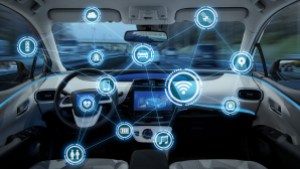 Simply defined, a connected car has internet access and can share data with devices inside and outside the vehicle. With cellular connectivity, cellular vehicle-to-everything (C-V2X) is expected to enhance safety and security on the road. In addition to the capability to connect to the cell network, C-V2X also means a connection between the car and the public infrastructure, a connection between two cars, and a connection between a car and pedestrian or road user by connecting to a mobile phone.
Simply defined, a connected car has internet access and can share data with devices inside and outside the vehicle. With cellular connectivity, cellular vehicle-to-everything (C-V2X) is expected to enhance safety and security on the road. In addition to the capability to connect to the cell network, C-V2X also means a connection between the car and the public infrastructure, a connection between two cars, and a connection between a car and pedestrian or road user by connecting to a mobile phone.
All of this connectivity goes hand in hand with the rise in autonomous vehicle (AV) technologies and vehicle safety trends, including advanced driver-assistance systems (ADAS), driver-monitoring systems, and automated emergency braking (AEB), as well as intelligent in-vehicle infotainment and smart cockpits for things like Wi-Fi connectivity and real-time traffic information.
The market is growing. The global connected car market is forecast to reach $225.2 billion by 2027, up from $63 billion in 2019, growing at a compound annual growth rate of 17.1% from 2020 to 2027, according to Allied Market Research. Along with a rise in connectivity solutions, safety and security is expected to drive growth over the next several years, with new opportunities coming from intelligent transportation systems and improved performance of AVs.
Together with more data from AVs, ADAS vehicles will also impact connected cars along with a need to keep updating road and map information. AVs will also create tremendous amounts of data, particularly from sensors such as camera sensors, radar, and LiDAR, said EE Times contributor Egil Juliussen.
There is still a lot of work that needs to be done for a truly connected car. One area is in precision navigation. Necessary for safe and efficient operation, precision navigation is the ability of vehicles and operators to continuously know their absolute and relative position in 3D space with high accuracy, repeatability, and confidence, and that precise position data needs to be available quickly, cost-effectively, and unrestricted by geography, according to ACEINNA and Omnitron Sensors.
There is still a need for higher-precision navigation systems that use a combination of sensors, said the companies, opening up an opportunity to improve both the accuracy and integrity of localization methodologies for precise navigation by incorporating real-time kinematics (RTK) into an inertial navigation solution. This combination of sensors and technologies all comes down to outcomes that are safe, precise, and predictable, they said.
There is no doubt that sensor technologies have a big role to play in automotive safety. More and more sensors are being deployed throughout the vehicle to address safety concerns proactively, said Anne-Françoise Pelé, editor-in-chief of EE Times Europe, and there may never be one most effective way to implement sensing technology for ADAS and AVs. But there will be fundamental considerations that every automaker will need to decide on to create its own unique approach to integrating sensors in future vehicles. Other challenges also need to be addressed, such as processing power, power consumption, thermal management, HMI, and, of course, cost.
For ADAS, radar and LiDAR sensing may have complementary roles to play. The next big thing in automotive radar will be 4D imaging radar, starting in 2021, according to Guillaume Girardin, division director, Photonics and Sensing, Yole Développement. The idea is to collect more data points and do more with it rather than filtering it, said Girardin, and it will help classify objects in addition to getting their relative position, distance, and velocity.
This is where LiDAR enters. It’s basically like 4D radar but works with infrared light, said Girardin, and the majority of OEMs integrating LiDAR are using it to enable automated driving features and to increase the safety and performance of AEB.
Automakers also have to carefully consider their interior and exterior lighting systems. Many are adding more intelligence to their lighting systems for improved safety. These include adaptive driving beam (ADB) technology that dynamically adjusts high beams based on the environment and “animated” lighting, such as in the cabin for driver-assistance prompts and vehicle status information as well as in lightbars for safety warning, advanced navigation, and blind-spot warning applications.
LEDs continue to make inroads for several reasons: high brightness, long life, high energy efficiency, and ability to control the light source. LED and driver manufacturers continue to innovate for automotive applications around performance, efficiency, integration, and size.
Even battery management has a role to play, particularly in electric vehicles. Self-driving connected cars will take us into a new transport era that is more efficient, economical, clean, and ecological, and lithium-ion (Li-ion) batteries and battery management systems will be key to that electric mobility, said Maurizio Di Paolo Emilio, editor-in-chief of Power Electronics News and EEWeb.
He believes that the growing focus on connected cars, perhaps with high-speed 5G networks, has been accelerated by the fact that they will be largely electric, and new component requirements needed for this evolution will center around several key areas: traction (electric engine, batteries, and transmission components), ADAS and autonomous functions, the application of new materials, and passenger compartment design.

A new book, AspenCore Guide to Sensors in Automotive: Making Cars See and Think Ahead, with contributions from leading thinkers in the safety and automotive industries, heralds the industry’s progress and identifies the engineering community’s remaining challenges.
It’s available now at the EE Times bookstore.
Advertisement





